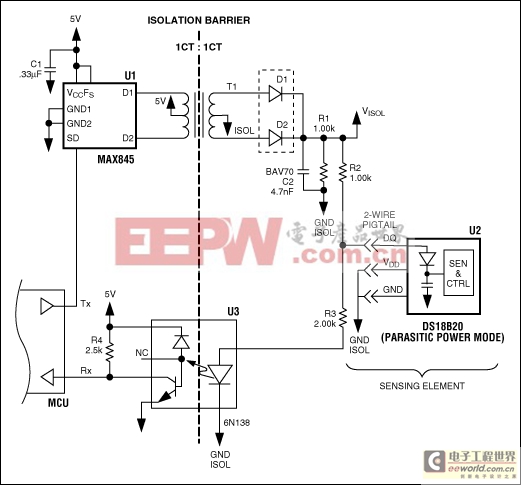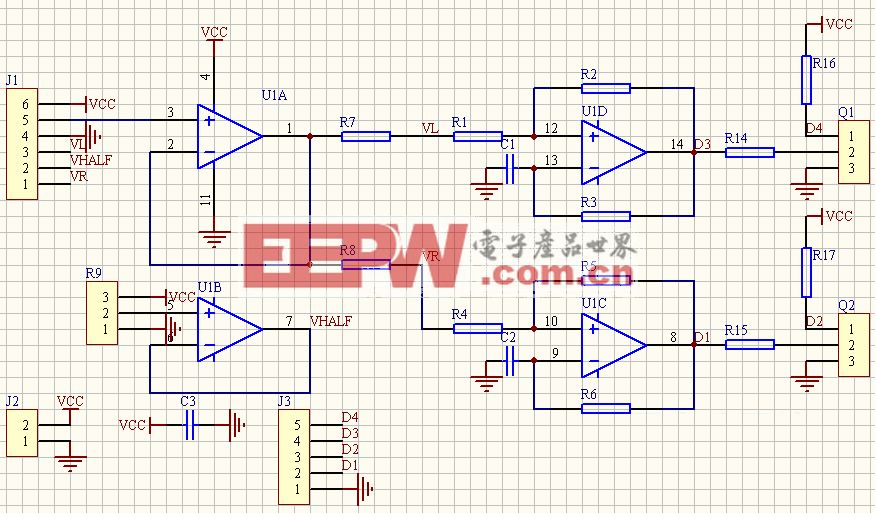單線串行總線載體隔離的電源和數(shù)據(jù)-Single-Wire
Medical and industrial applications often require galvanic isolation of 2500VAC or higher for the safety of patients and equipment operators. The isolation barrier conveys not only power to the sensing element, but also data to or from that element. Each data signal crossing the barrier requires isolation, so one typically saves costs in these applications by choosing a serial bus rather than a parallel bus. Serial buses include SPI, I2C, and the Dallas 1-Wire bus.
The Dallas Semiconductor 1-Wire requires only a single data line (plus ground) for bidirectional communications. Because opto-isolators are unidirectional devices, typical 1-Wire applications require two optos, one for each direction of data flow. (SPI and I2C applications require a minimum of three optos.) The 1-Wire bus can also transfer power in its "parasitic power mode." An isolated converter provides power for the sensing element. Thus, most 1-Wire designs require two optos for the data interface, one opto for feedback to the isolated power supply, and a transformer for isolation of the power supply.
The circuit of Figure 1, implemented with an isolated transformer driver (U1) and a single optocoupler, minimizes the component count required for isolation while maintaining a two-wire pigtail design (data plus ground to the 1-Wire sensing element). U1 provides isolated and psuedo-regulated power while enabling the master to transmit data to the 1-Wire device across an isolated interface. Locating the single opto in the receive data path allows the master to receive isolated data from the 1-Wire device.

Figure 1. Using the Dallas Semiconductor 1-Wire serial bus, this interface circuit provides isolated power and bidirectional communications between a master (MCU) and a sensing element.
Note the following miscellaneous observations:
- U1 and transformer T1 generate approximately 4.0V at the VISOL node (upper right corner of the schematic).
- D1 and D2 implement a half-bridge rectifier for the transformer secondary.
- The connection between FS and VCC on U1 causes that device to switch at a nominal 860kHz.
- Capacitor C2 filters the output and maintains the output level between positive cycles.
- R1 is included to discharge capacitor C2.
- The voltage levels on the DQ node satisfy the DC requirements specified in the DS18B20 data sheet. However, the functionality of the circuit was not tested with a DS18B20 or any other 1-Wire device.
To initiate communication, the MCU asserts a Reset Pulse by forcing SD high, turning off U1. With U1 off, the voltage at VISOL drops to the logic-low level of the 1-Wire device. You should select R1, R2, R3, and C2 to allow VISOL to fall below the logic-low threshold (0.8V) in less than approximately 5μs. (Note that using R1 = R2 = 1.00k, R3 = 2.00k, and C2 = 4.7nF provide a starting point for testing, but final values depend on the opto selected.) While U1 is active, these four values must not allow VISOL to dip below the 2.4V logic-high threshold of the 1-Wire device.
For the MCU to receive data from the 1-Wire device, the opto (U3) is modulated by the level of VISOL or by the data pin of the 1-Wire device (DQ). When U1 is ON, the LED in U3 is ON, thus forcing Rx low. When the 1-Wire device pulls DQ low, the LED turns off and Rx goes high. Rx also goes high when U1 turns off, thereby causing VISOL to drop and turn off the LED. (Tx and Rx logic for the MCU is the inverse of that for the 1-Wire device.)
Thus, a single opto, a transformer, and a Dallas Semiconductor 1-Wire serial link form an isolated sensor interface between a MCU and a precision 1-Wire thermometer. By keeping the wiring and component costs to a minimum, this circuit supports high-volume medical and industrial applications.
A similar article appeared as a Design Ides in the October 13, 2005 edition of Electronic Design magazine.








評論